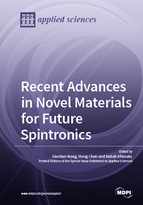Recent Advances in Novel Materials for Future Spintronics
A special issue of Applied Sciences (ISSN 2076-3417). This special issue belongs to the section "Materials Science and Engineering".
Deadline for manuscript submissions: closed (31 January 2019) | Viewed by 41590
Special Issue Editors
Interests: magnetic and topological materials; half-metals; spin -gapless semiconductors; topological semimetals; topological phonons
Special Issues, Collections and Topics in MDPI journals
Interests: theoretical studies of hadronic and nuclear structures; first-principles studies of solid materials and clusters
Interests: materials sciences and computational physics using ab initio methods; DFT calculations of the physical properties of crystalline solids - insulators, metals, semiconductors or half metallic; optoelectronic properties; structural phase transformations; mechanical; thermodynamics and thermoelectric properties; strong-correlated systems; the effect of pressure and temperature on the physical properties of materials
Special Issue Information
Dear Colleagues,
As we all know, electrons carry both charge and spin. The processing of information in conventional electronic devices is based only on the charge of electrons. Spin electronics, or spintronics, uses the spin of electrons, as well as their charge, to process information. Metals, semiconductors and insulators are the basic materials that constitute the components of electronic devices, and these have been transforming all aspects of society for over a century. In contrast, magnetic metals, half-metals (including zero-gap half-metals), magnetic semiconductors (including spin-gapless semiconductors), dilute magnetic semiconductors and magnetic insulators are the materials that will form the basis for spintronic devices.
This Special Issue aims to collect a range papers on novel materials which have intriguing physical properties and numerous potential practical applications in spintronics. With immense pleasure, we invite you to submit a manuscript to this Special Issue; original research papers and reviews are welcome.
Potential topics include, but are not limited to, the following:
- Electrical, optical, magnetic, and thermal properties of new spintronic materials.
- Experimental techniques for characterization of spintronic materials and materials properties.
- Physics, chemistry and theory of the solid state.
- Interfaces in the solid state.
- Topological insulators and topological semimetals.
- Recent advance in Solid State and Materials Science.
Dr. Xiaotian Wang
Prof. Dr. Hong Chen
Prof. Dr. Rabah Khenata
Guest Editors
Manuscript Submission Information
Manuscripts should be submitted online at www.mdpi.com by registering and logging in to this website. Once you are registered, click here to go to the submission form. Manuscripts can be submitted until the deadline. All submissions that pass pre-check are peer-reviewed. Accepted papers will be published continuously in the journal (as soon as accepted) and will be listed together on the special issue website. Research articles, review articles as well as short communications are invited. For planned papers, a title and short abstract (about 100 words) can be sent to the Editorial Office for announcement on this website.
Submitted manuscripts should not have been published previously, nor be under consideration for publication elsewhere (except conference proceedings papers). All manuscripts are thoroughly refereed through a single-blind peer-review process. A guide for authors and other relevant information for submission of manuscripts is available on the Instructions for Authors page. Applied Sciences is an international peer-reviewed open access semimonthly journal published by MDPI.
Please visit the Instructions for Authors page before submitting a manuscript. The Article Processing Charge (APC) for publication in this open access journal is 2400 CHF (Swiss Francs). Submitted papers should be well formatted and use good English. Authors may use MDPI's English editing service prior to publication or during author revisions.








